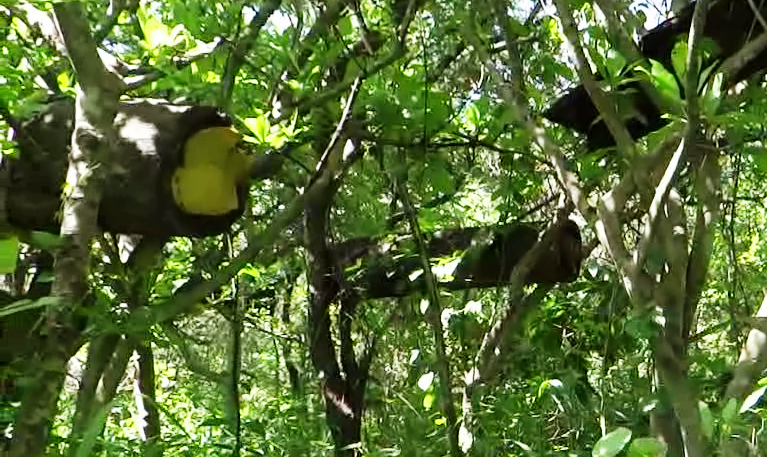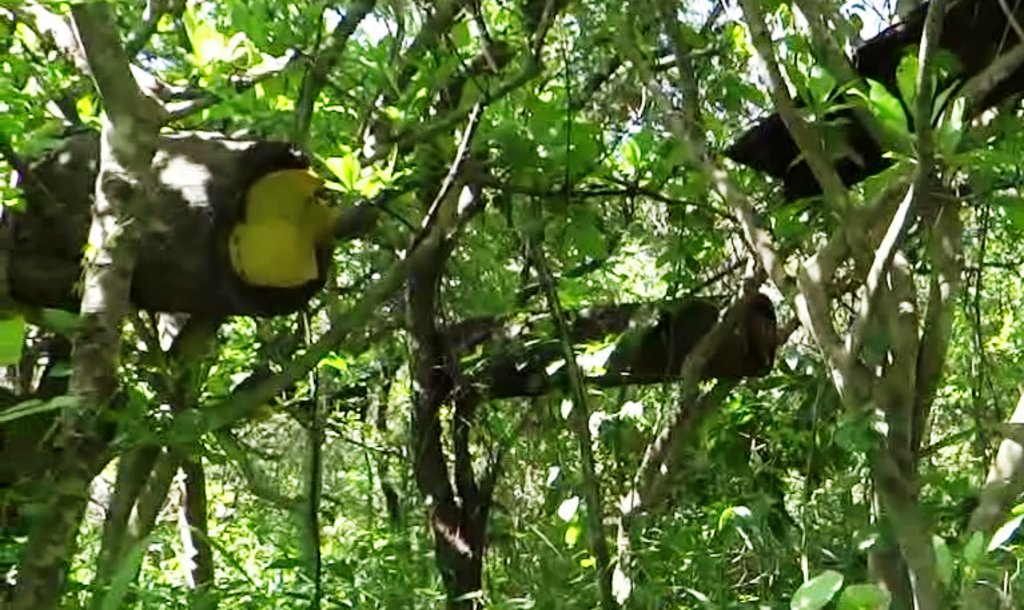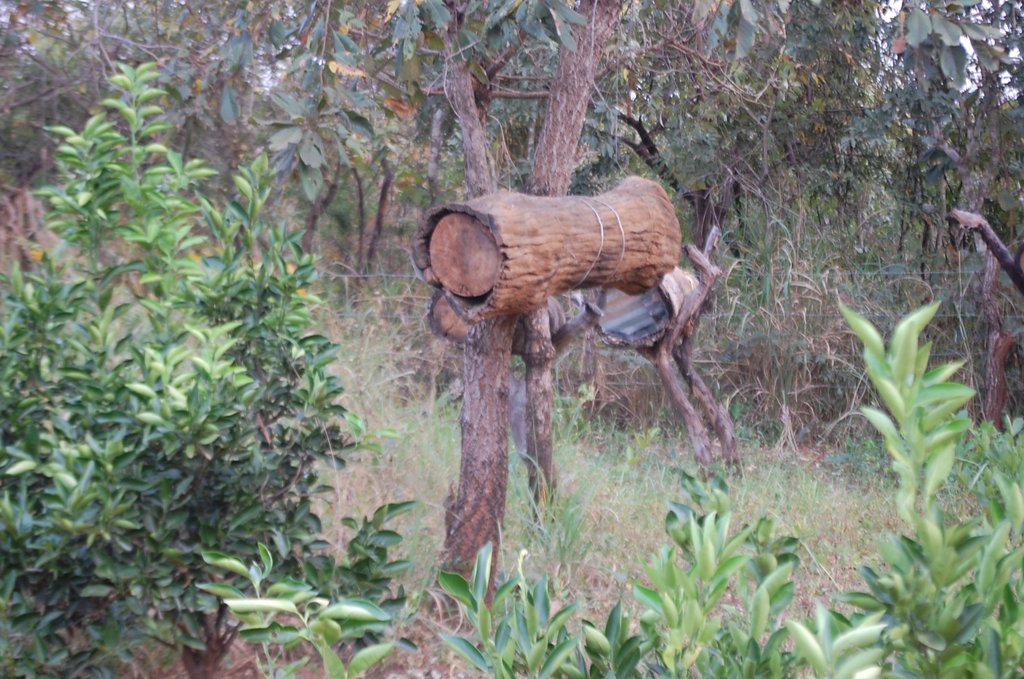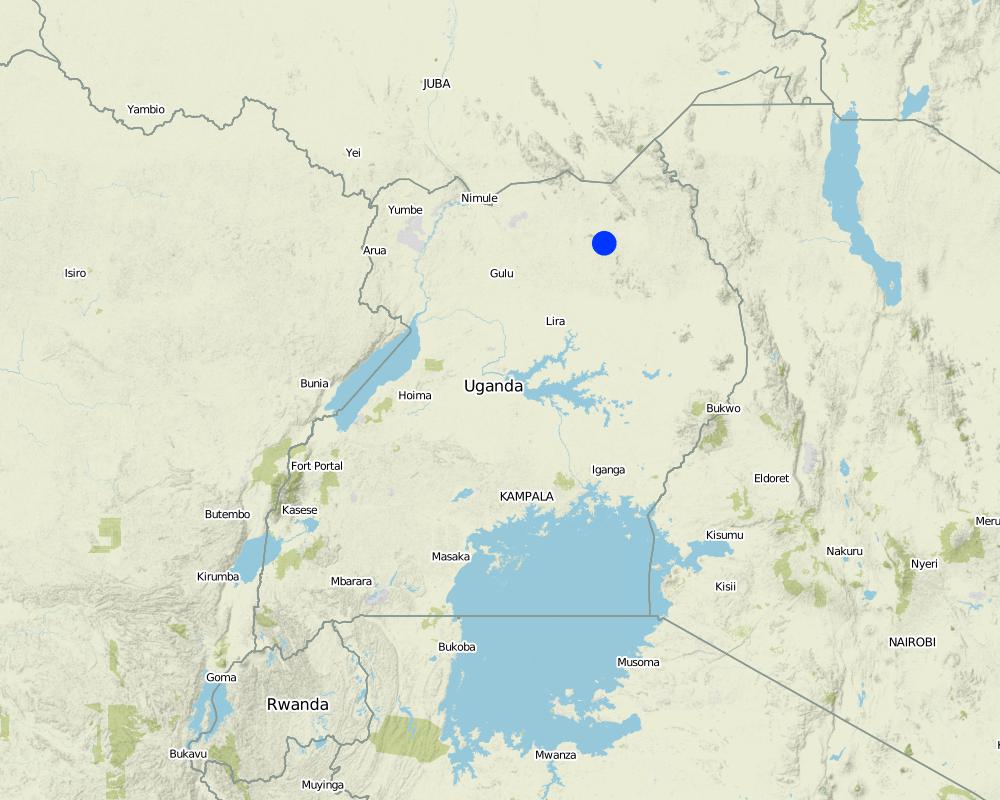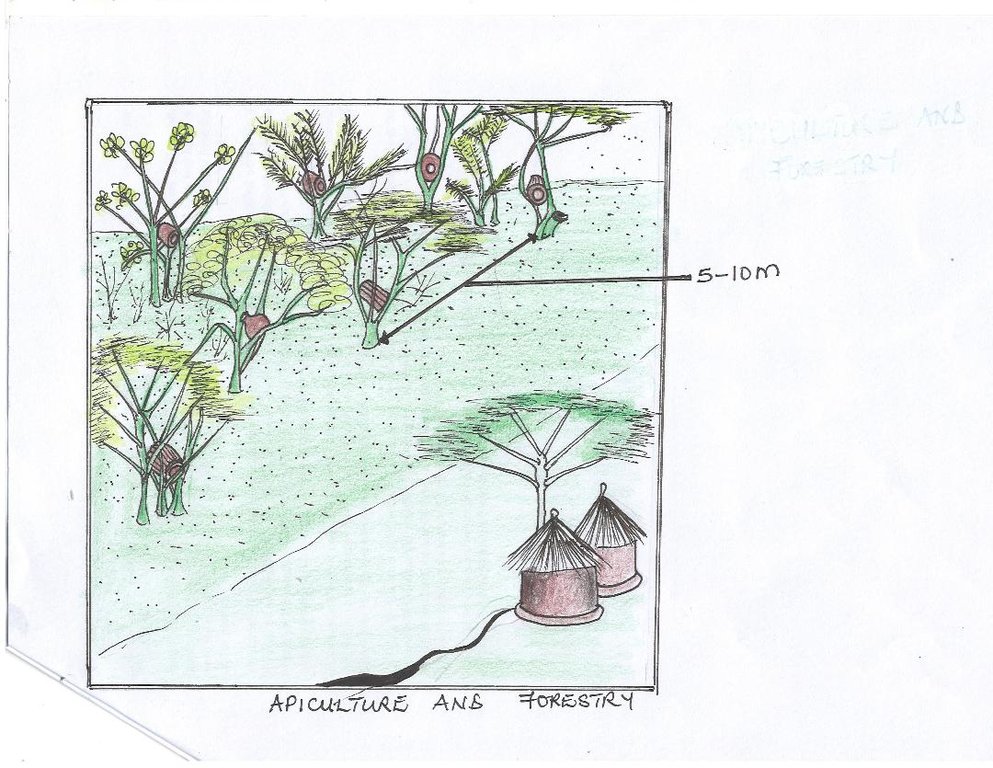Integrated Apiculture and Forestry [Uganda]
- Creation:
- Update:
- Compiler: Kamugisha Rick Nelson
- Editors: JOY TUKAHIRWA, Sunday Balla Amale, Richard Otto Kawawa, Bernard Fungo
- Reviewers: Drake Mubiru, Nicole Harari, Renate Fleiner, Stephanie Jaquet, Donia Mühlematter
Penywii bee keepers association
technologies_2257 - Uganda
View sections
Expand all Collapse all1. General information
1.2 Contact details of resource persons and institutions involved in the assessment and documentation of the Technology
Key resource person(s)
SLM specialist:
Odora Phillip
0775594364
Penywi beekeeping association
Akwang Village, Taa Parish, Paimol Sub-county,
Uganda
Name of project which facilitated the documentation/ evaluation of the Technology (if relevant)
Scaling-up SLM practices by smallholder farmers (IFAD)Name of the institution(s) which facilitated the documentation/ evaluation of the Technology (if relevant)
CDE Centre for Development and Environment (CDE Centre for Development and Environment) - Switzerland1.3 Conditions regarding the use of data documented through WOCAT
When were the data compiled (in the field)?
10/05/2017
The compiler and key resource person(s) accept the conditions regarding the use of data documented through WOCAT:
Yes
1.4 Declaration on sustainability of the described Technology
Is the Technology described here problematic with regard to land degradation, so that it cannot be declared a sustainable land management technology?
No
2. Description of the SLM Technology
2.1 Short description of the Technology
Definition of the Technology:
Maintaining colonies of honey bees within trees and shrubs for environmental conservation and household income.
2.2 Detailed description of the Technology
Description:
Integrated apiculture and forestry technology is promoted and practiced by farmers with small, medium or large scale land holdings of 0.5 acres to 10 with an average of 5-28 local bee hives or more. The farmer may decide to increase the number of the beehives when he sells honey and he gets income.
The farmer (1) identifies the land with trees and shrubs where Local wooden bee hives made in rectangular shape are cited in a distance of not less than 5 -10 metres from one hive to the other (2) Clean the surrounding to reduce the weeds around the cited area (3) cite the beehives within the tree and shrubs (4) keep monitoring bush fires and thieves.
The necessary labour requirements for establishment of this technology include wooden beehives made locally and 4 people to install the bee hives who are paid on daily or monthly basis depending on request.
The benefits from this SLM technology are slightly negative due to the high costs of local bee hives at the time of establishment but positive in the long term of environmental conservation, honey provision and increased income from the sale of honey in addition to using local materials obtained locally associated with low costs.
Wild fires are a common threat during the dry seasons and in order to overcome this issue, it is needed to constantly keep monitoring and establish fire lines to guard against the wild fires
2.3 Photos of the Technology
2.4 Videos of the Technology
Comments, short description:
Video link showing Integrated apiculture and forestry in Akwang Village, TAA parish, Paimol Sub-county, Agago District.
Date:
10/05/2017
Location:
Akwang Village, TAA Parish, Paimol Sub-county, Agago District
Name of videographer:
Rick Kamugisha
2.5 Country/ region/ locations where the Technology has been applied and which are covered by this assessment
Country:
Uganda
Region/ State/ Province:
Northern Region,Uganda
Further specification of location:
Agago District
Comments:
Map showing technology site in Northern Uganda.
Map
×2.6 Date of implementation
Indicate year of implementation:
2013
If precise year is not known, indicate approximate date:
- less than 10 years ago (recently)
2.7 Introduction of the Technology
Specify how the Technology was introduced:
- through projects/ external interventions
Comments (type of project, etc.):
National Agricultural Advisory Services (NAADS ) supported with training.
3. Classification of the SLM Technology
3.1 Main purpose(s) of the Technology
- improve production
- reduce, prevent, restore land degradation
- conserve ecosystem
- mitigate climate change and its impacts
- create beneficial economic impact
3.2 Current land use type(s) where the Technology is applied

Forest/ woodlands
(Semi-)natural forests/ woodlands:
- Selective felling
Products and services:
- Fuelwood
- Nature conservation/ protection
Comments:
Conserved for bee keeping with selective felling and firewood.
3.3 Further information about land use
Water supply for the land on which the Technology is applied:
- rainfed
Number of growing seasons per year:
- 2
Specify:
Harvest twice year during the dry season June /July, December /January
3.4 SLM group to which the Technology belongs
- forest plantation management
- beekeeping, aquaculture, poultry, rabbit farming, silkworm farming, etc.
3.5 Spread of the Technology
Specify the spread of the Technology:
- evenly spread over an area
If the Technology is evenly spread over an area, indicate approximate area covered:
- < 0.1 km2 (10 ha)
Comments:
0,5 acres
3.6 SLM measures comprising the Technology

agronomic measures
- A1: Vegetation/ soil cover
- A2: Organic matter/ soil fertility

vegetative measures
- V1: Tree and shrub cover
- V3: Clearing of vegetation

structural measures
- S9: Shelters for plants and animals

management measures
- M1: Change of land use type
3.7 Main types of land degradation addressed by the Technology

biological degradation
- Bc: reduction of vegetation cover
- Bh: loss of habitats
- Bf: detrimental effects of fires
- Bp: increase of pests/ diseases, loss of predators
3.8 Prevention, reduction, or restoration of land degradation
Specify the goal of the Technology with regard to land degradation:
- prevent land degradation
- reduce land degradation
Comments:
No cultivation that take place where the bee hives are installed. This reduces and prevents degradation
4. Technical specifications, implementation activities, inputs, and costs
4.1 Technical drawing of the Technology
4.2 Technical specifications/ explanations of technical drawing
The farmer installs the technology on 0.5 - 10 acres of land with an average of 5-28 local wooden bee hives put in the forest / tree plantation in a distance of not less than 5 -10 metres from one bee hive to the other.
4.3 General information regarding the calculation of inputs and costs
Specify how costs and inputs were calculated:
- per Technology area
Indicate size and area unit:
0.5 acres
other/ national currency (specify):
UGX
Indicate exchange rate from USD to local currency (if relevant): 1 USD =:
3400.0
Indicate average wage cost of hired labour per day:
5000
4.4 Establishment activities
| Activity | Type of measure | Timing | |
|---|---|---|---|
| 1. | Site selection (location, distance) | Structural | Once before establishment |
| 2. | Look for labour to clear | Other measures | Once before estsblishment/ can be routine |
| 3. | Clear the sorrounding | Vegetative | During establishment/ Routine |
| 4. | Buy the local wooden bee hives | Other measures | Once during establishment |
| 5. | Installation of the beehives | Structural | During establishment |
Comments:
The farmerrelies on family labour to install the bee hives.
4.5 Costs and inputs needed for establishment
| Specify input | Unit | Quantity | Costs per Unit | Total costs per input | % of costs borne by land users | |
|---|---|---|---|---|---|---|
| Labour | Persons days on monthly basis | persons | 4.0 | 150000.0 | 600000.0 | 100.0 |
| Equipment | Bee hives | Pieces | 25.0 | 75000.0 | 1875000.0 | 100.0 |
| Other | Transport for bee hives | Number | 1.0 | 250000.0 | 250000.0 | |
| Other | 100.0 | |||||
| Total costs for establishment of the Technology | 2725000.0 | |||||
Comments:
High cost of buying local wooden bee hives compared to labour and transport cost.
4.6 Maintenance/ recurrent activities
| Activity | Type of measure | Timing/ frequency | |
|---|---|---|---|
| 1. | Slashing | Management | Twice a year |
| 2. | Making fireline to pevent fires | Structural | Once a year but this requires maintanance |
| 3. | Monitoring | Management | Daily |
| 4. | Supervision | Management | Daily |
Comments:
Replacement of bee hives is done when the bee hives are spoilt / stolen but this may take longer time without replacement.
4.7 Costs and inputs needed for maintenance/ recurrent activities (per year)
| Specify input | Unit | Quantity | Costs per Unit | Total costs per input | % of costs borne by land users | |
|---|---|---|---|---|---|---|
| Labour | Persons days for slashing, making fireline, monitoring | persons | 4.0 | 150000.0 | 600000.0 | 100.0 |
| Other | Transport | 1 | 1.0 | 250000.0 | 250000.0 | 100.0 |
| Total costs for maintenance of the Technology | 850000.0 | |||||
Comments:
High costs of labour for maintaining the technology compared to other inputs.
4.8 Most important factors affecting the costs
Describe the most determinate factors affecting the costs:
Purchase of bee hives.
5. Natural and human environment
5.1 Climate
Annual rainfall
- < 250 mm
- 251-500 mm
- 501-750 mm
- 751-1,000 mm
- 1,001-1,500 mm
- 1,501-2,000 mm
- 2,001-3,000 mm
- 3,001-4,000 mm
- > 4,000 mm
Specify average annual rainfall (if known), in mm:
1350.00
Specifications/ comments on rainfall:
Two dry season and two wet season : Dry season June to August and January to February
Wet season: March to May and September to December
Agro-climatic zone
- humid
5.2 Topography
Slopes on average:
- flat (0-2%)
- gentle (3-5%)
- moderate (6-10%)
- rolling (11-15%)
- hilly (16-30%)
- steep (31-60%)
- very steep (>60%)
Landforms:
- plateau/plains
- ridges
- mountain slopes
- hill slopes
- footslopes
- valley floors
Altitudinal zone:
- 0-100 m a.s.l.
- 101-500 m a.s.l.
- 501-1,000 m a.s.l.
- 1,001-1,500 m a.s.l.
- 1,501-2,000 m a.s.l.
- 2,001-2,500 m a.s.l.
- 2,501-3,000 m a.s.l.
- 3,001-4,000 m a.s.l.
- > 4,000 m a.s.l.
Indicate if the Technology is specifically applied in:
- concave situations
5.3 Soils
Soil depth on average:
- very shallow (0-20 cm)
- shallow (21-50 cm)
- moderately deep (51-80 cm)
- deep (81-120 cm)
- very deep (> 120 cm)
Soil texture (topsoil):
- coarse/ light (sandy)
Soil texture (> 20 cm below surface):
- medium (loamy, silty)
Topsoil organic matter:
- medium (1-3%)
5.4 Water availability and quality
Ground water table:
5-50 m
Availability of surface water:
excess
Water quality (untreated):
good drinking water
Is water salinity a problem?
No
Is flooding of the area occurring?
No
5.5 Biodiversity
Species diversity:
- medium
Habitat diversity:
- medium
5.6 Characteristics of land users applying the Technology
Sedentary or nomadic:
- Sedentary
Market orientation of production system:
- subsistence (self-supply)
- mixed (subsistence/ commercial
Off-farm income:
- less than 10% of all income
Relative level of wealth:
- average
Individuals or groups:
- individual/ household
Level of mechanization:
- manual work
- animal traction
Gender:
- women
- men
Age of land users:
- youth
- middle-aged
Indicate other relevant characteristics of the land users:
Owns a shop from which she derives more income.
The technology is applied by both men and women but majorly by men. Women use hired men to provide labour.
5.7 Average area of land owned or leased by land users applying the Technology
- < 0.5 ha
- 0.5-1 ha
- 1-2 ha
- 2-5 ha
- 5-15 ha
- 15-50 ha
- 50-100 ha
- 100-500 ha
- 500-1,000 ha
- 1,000-10,000 ha
- > 10,000 ha
Is this considered small-, medium- or large-scale (referring to local context)?
- small-scale
Comments:
Own 0.5 acres of land.
5.8 Land ownership, land use rights, and water use rights
Land ownership:
- individual, not titled
Land use rights:
- open access (unorganized)
- individual
Water use rights:
- communal (organized)
5.9 Access to services and infrastructure
health:
- poor
- moderate
- good
education:
- poor
- moderate
- good
technical assistance:
- poor
- moderate
- good
employment (e.g. off-farm):
- poor
- moderate
- good
markets:
- poor
- moderate
- good
energy:
- poor
- moderate
- good
roads and transport:
- poor
- moderate
- good
drinking water and sanitation:
- poor
- moderate
- good
financial services:
- poor
- moderate
- good
6. Impacts and concluding statements
6.1 On-site impacts the Technology has shown
Socio-economic impacts
Production
forest/ woodland quality
Comments/ specify:
The conserved trees and shrubs integrated with bee hives.
land management
Comments/ specify:
Where the bee hives are installed, no cultivation and grazing activities are taking place.
Income and costs
expenses on agricultural inputs
Comments/ specify:
Uses local wooden materials.
farm income
Comments/ specify:
From the sale of honey.
diversity of income sources
Comments/ specify:
Sale of honey and firewood.
workload
Comments/ specify:
Required for Slashing , installation and carrying bee hives during establishment. This reduces over time.
Socio-cultural impacts
SLM/ land degradation knowledge
Comments/ specify:
Installation and spacing the bee hives.
Establishing fire line.
Ecological impacts
Water cycle/ runoff
surface runoff
Comments/ specify:
Presence of protected trees and shrubs.
Soil
soil cover
Comments/ specify:
Presence of growing vegetation in the apiary.
soil loss
Comments/ specify:
presence of rees and shrubs protect the soil from run off
soil organic matter/ below ground C
Comments/ specify:
Decomposition of the leaves from the trees.
Biodiversity: vegetation, animals
plant diversity
Comments/ specify:
More trees and shrubs grow as result of protected apiary.
Climate and disaster risk reduction
fire risk
Comments/ specify:
Presence of fireline.
6.2 Off-site impacts the Technology has shown
water availability
Comments/ specify:
Presence of a check dam where bees get water .
Comments regarding impact assessment:
Generally the protected trees where the beehives are installed have a positive impact on the environment because no destructive human activities are taking place
6.3 Exposure and sensitivity of the Technology to gradual climate change and climate-related extremes/ disasters (as perceived by land users)
Gradual climate change
Gradual climate change
| Season | Type of climatic change/ extreme | How does the Technology cope with it? | |
|---|---|---|---|
| annual temperature | decrease | well | |
| seasonal temperature | wet/ rainy season | decrease | well |
Climate-related extremes (disasters)
Climatological disasters
| How does the Technology cope with it? | |
|---|---|
| forest fire | moderately |
Biological disasters
| How does the Technology cope with it? | |
|---|---|
| insect/ worm infestation | well |
6.4 Cost-benefit analysis
How do the benefits compare with the establishment costs (from land users’ perspective)?
Short-term returns:
slightly negative
Long-term returns:
slightly positive
How do the benefits compare with the maintenance/ recurrent costs (from land users' perspective)?
Short-term returns:
slightly negative
Long-term returns:
slightly positive
Comments:
High costs for buying beehives and paying labour compared to benefits which are rather low in the long term associated with obtaining income from the sale of honey.
6.5 Adoption of the Technology
- single cases/ experimental
If available, quantify (no. of households and/ or area covered):
This is a demosntration for farmers learning.
Of all those who have adopted the Technology, how many have did so spontaneously, i.e. without receiving any material incentives/ payments?
- 10-50%
Comments:
The farmer is a model farmer supported by Operation Wealth Creation. So farmers are encouraged to come and learn without any incentive like transport or any other addtional support.
6.6 Adaptation
Has the Technology been modified recently to adapt to changing conditions?
No
6.7 Strengths/ advantages/ opportunities of the Technology
| Strengths/ advantages/ opportunities in the land user’s view |
|---|
| Helps control soil erosion because the land user does not dig where the bee hives are established. |
| Provide income from the sale of honey. |
| Can easily be replicated to other areas. |
| Uses locally obtained materials. |
| Easy to establish and maintain with minimum costs when the farmer has enough money. |
| Strengths/ advantages/ opportunities in the compiler’s or other key resource person’s view |
|---|
| The technology uses materials which are locally obtained. |
6.8 Weaknesses/ disadvantages/ risks of the Technology and ways of overcoming them
| Weaknesses/ disadvantages/ risks in the land user’s view | How can they be overcome? |
|---|---|
| Requires technical knowledge on spacing and processing wax which is 20% of total honey produced. | Provide training to the land user on how to add value to the wax. |
| The technology is liked by pests (obusinsibirizi) in the local language. | Training on how to control pests for increased production . |
| Thieves like stealing the honey. The technology is a good attraction for thieves. | Facilitate formation of local level by-laws and enforcement of strong fines and bylaws. |
| Weaknesses/ disadvantages/ risks in the compiler’s or other key resource person’s view | How can they be overcome? |
|---|---|
| Affected by Wild fires. | Promote firebreaks to guard against fires. |
7. References and links
7.1 Methods/ sources of information
- field visits, field surveys
01 - Land user
- interviews with land users
01- land user
- interviews with SLM specialists/ experts
01 specialist - To provide the compilers or key resource persons view.
Links and modules
Expand all Collapse allLinks
No links
Modules
No modules


